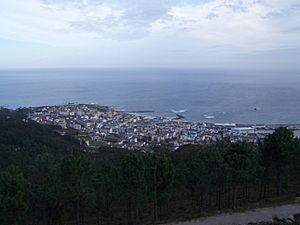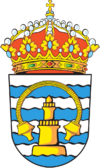Burela facts for kids
Quick facts for kids
Burela
|
|||
|---|---|---|---|
 |
|||
|
|||
| Parroquias | Burela (Santa María de Burela) | ||
| Area | |||
| • Total | 8.2 km2 (3.2 sq mi) | ||
| Population
(2018)
|
|||
| • Total | 9,566 | ||
Burela is a cool coastal town in Galicia, Spain. It's located in the province of Lugo, right by the Cantabrian Sea. Burela became its own town in 1994, separating from a nearby place called Cervo.
This town has a very important fishing port. Many ships sail from here to catch fish. Burela's economy mainly depends on fishing, especially for fish like albacore (also known as "bonito del norte") and hake. These fish are sent all over Spain. Because of all the fishing, Burela also has factories that can and preserve fish.
Burela is a town with people from many different countries. Many residents are from Cape Verde, and recently, people from Peru, Indonesia, and other places have moved here. This mix of cultures makes Burela a vibrant place to live. The town's population grew a lot in the late 1900s.
Contents
Exploring Burela's Past
The history of Burela goes back a very long time, even before the Romans arrived.
Ancient Beginnings: Iron Age Forts
The oldest signs of people living in Burela were found at a fort on the end of a cape. The people who lived in these forts left behind a special piece of jewelry called a torque. This torque is a symbol of the Iron Age culture in the area. Today, you can see it in the Provincial Museum of Lugo. It's even part of Burela's official coat of arms!
When Did Burela Get Its Name?
The first time Burela was mentioned in writing was in a document from 1096. Back then, it was called "Burellum." No one is quite sure where the name "Burela" came from. Burela officially became independent from Cervo in 1994.
Roman Times and Beyond
Close to the old Iron Age fort, there was a small Roman settlement. This little village grew into a rural community. It became a parish, which is like a church district, dedicated to Saint Mary. It was part of the Diocese of Saint Martin of Mondoñedo.
Burela was controlled by the church for a long time. But in 1593, King Felipe II changed things. He made Burela part of the Royal Crown's land. He also gave a special document to the Bishop of Mondoñedo.
New Councils and Independence
When the Constitution of the Courts of Cadiz was created in 1812, it ended the old ways of control by churches and lords. New local councils, called municipalities, were formed. In 1835, a list of these new councils was published. It included the municipalities of San Cibrao and Nois. The parish of Burela was part of Nois at that time.
Who Lives in Burela?
Burela is home to more than 9,000 people today. The average age of people living here is about 36 years old. This makes Burela one of the younger towns in the province of Lugo.
Population Growth in the 1900s
The town's population grew a lot in the late 1970s and 1980s. Many families moved to Burela from other parts of Spain, like Asturias and Castile and León. They came because a large public company, Alúmina Alumino, set up in San Cibrao. This company is now private and called Alcoa.
Around this time, the community of people from Cape Verde also started to grow significantly in Burela. This has made Burela a truly diverse and welcoming place.
See also
 In Spanish: Burela para niños
In Spanish: Burela para niños



